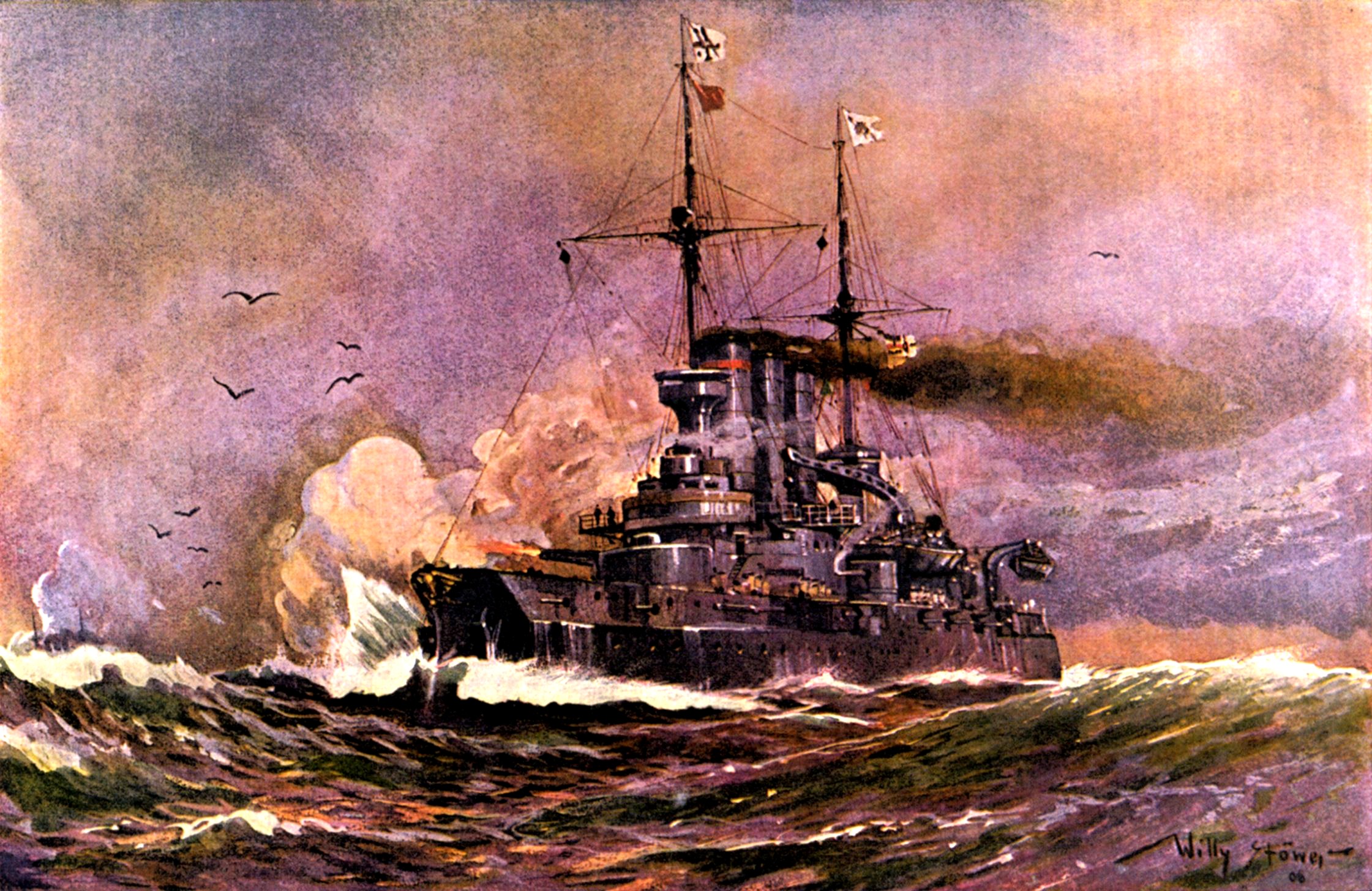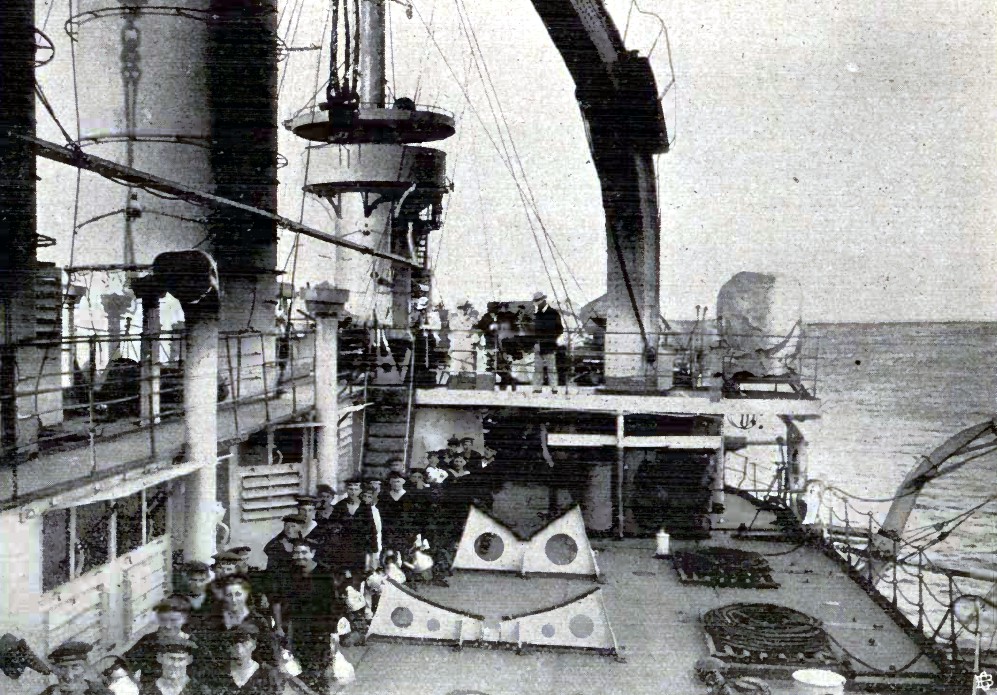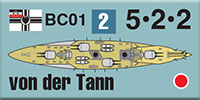| Jutland 2e:
Tirpitz’s Battleships, Part Three
By Mike Bennighof, Ph.D.
September 2024
 With the battleships authorized by the Naval Law of 1898 on the slipways, Germany’s Navy State Secretary, Alfred Tirpitz, wanted still more, as did his kaiser. The opportunity appeared in December 1899, when a British cruiser seized the German steamer Bundesrath on suspicion of carrying arms to the Boer Republics, then at war with Britain. With the battleships authorized by the Naval Law of 1898 on the slipways, Germany’s Navy State Secretary, Alfred Tirpitz, wanted still more, as did his kaiser. The opportunity appeared in December 1899, when a British cruiser seized the German steamer Bundesrath on suspicion of carrying arms to the Boer Republics, then at war with Britain.
German public opinion strongly supported the Boers, German industry had armed them, and the German Kaiser had written an ill-considered 1895 telegram in their support. The seizure inflamed public opinion, which only grew more heated as the Royal Navy grabbed three more steamers and a sailing barque in less than two weeks. The Imperial government protested, and the British paid compensation, but the outrage continued - not least because Tirpitz prompted the supposedly independent Navy League to keep stoking it.
By June 1900, Tirpitz had his Second Naval Law as the Conservatives dropped their earlier opposition and joined with the Catholic Center Party to pass the bill by a solid 2:1 majority. It called for twice as many battleships as the First Law, 38 against 19, to be completed by 1917. The total number of newly-built battleships was actually 24 more, since the five decrepit ironclads of the Sachsen and Oldenburg classes could be replaced shortly without counting against the total. It was a complete legislative victory for Tirpitz; Kaiser Wilhelm II celebrated by elevating him and four other senior admirals to the Prussian nobility.

Tirpitz decided on a class of ten new battleships, with two new ships laid down for each of the next five years. Kaiser Friedrich III had been commissioned and show her flaws; chiefly, her lightweight 240mm main armament and the awkward loading arrangements that cancelled the supposedly rapid-fire qualities of the gun itself. Tirpitz gave into the demands for a new, heavier 280mm (11-inch) main gun, accepting that this would mean a larger ship built to a new design. But at least he would have ten of them, a second homogenous group matching the Kaiser Friedrich III and Wittelsbach classes.
The new chief of the Construction Department, Johannes Rudloff, had charge of the new ship’s design. He drafted a design from the keel up to take full advantage of the Krupp cemented armor; the preceding Wittelsbach had had this protection as well but her designer, Alfred Dietrich, had been constrained by Tirpitz’s insistence on speeding construction to follow the Kaiser Friedrich III pattern as closely as possible.
Germany had no modern 280mm gun, despite the constant discussions of fitting such a weapon to the two previous classes of battleships. Krupp had the task of designing both the gun and the new Drh.L. C/01 twin turret in which it would be mounted. Meanwhile, Rudloff kept drafting and his team hoped that the new weapon would work as its specifications demanded.

WIlli Stower’s rather fanciful 1906 painting of SMS Preussen in action.
The new ship would also see a matching increase in her secondary armament, going from eighteen 150mm (5.9-inch) guns to fourteen new 170mm (6.75-inch) weapons: four of them in single turrets, and the other ten in an armored casemate. The 17cm/40 SK/L40 offered somewhat better range and considerably more striking power than the earlier weapon, tossing a shell weighing half again as much as the 150mm gun. That presented a serious problem: the 40 kilo (88 pound) shell of the 150mm gun was about the maximum that a single, brawny gunner could shove into the breach by himself. At 64 kilos (141 pounds), a sailor would have had to be seriously pumped up to sling it around by hand. In practice, two men had to handle the shell, which greatly reduced its rate of fire. The 170mm gun was considered a signal failure, and not used again after this became apparent.
The new ship, to be named Braunschweig (all class members would be named for German provinces), would displace 13,000 tons, compared to 11,000 for Wittelsbach. Braunschweig was only slightly longer and somewhat wider than the earlier battleship; most of the weight increase went into the new guns, turrets, and barbettes. She did keep the tight “honeycomb” internal subdivision of the earlier battleships, a feature of all heavy ships built by Imperial Germany in this period.

The crew of SMS Elsass line up for their tea ration. Travemünde, 1908.
Rudloff gave her a wide armored belt, sited high enough that it would not be submerged when the ship was at her full load displacement. Armor thicknesses remained unchanged from those of Wittelsbach, but Rudloff gave his new ship better distribution. Underwater protection remained no better than that of other pre-dreadnoughts. All told, though, Germany finally had a battleship equivalent to those of other sea-faring nations.
Tirpitz altered purchasing arrangements for the new class, to test out a new set of protocols designed to control cost overruns, and to reward those shipbuilders that had agreed to them. All five contracts went to private yards: two to the Krupp-owned Germaniawerft of Kiel, two to Schichau of Danzig, and one to AG Vulkan’s Stettin yard. For this round, at least, the shipyards all kept their costs close to what Tirpitz demanded; Krupp and Schichau tried to work around the new system by greatly padding the costs for ships’ boats, while Vulkan tried to hide extra profit in the billing for hammocks, clothing, and other crew gear.

Period postcard of SMS Hessen. Sometime pre-war.
The ships delivered close to their contracted times, with the first commissioning in October 1904 and the last in May 1906. They all joined the Active Battle Force, soon to be re-named the High Seas Fleet, and soon enough became obsolete as the British unveiled their new Dreadnought. They formed the II Battle Squadron, but the first went into reserve in 1912 and the second a year later, leaving three ships still active when war came in August 1914, aborting plans to mothball two more of them.
The three active ships remained with the High Seas Fleet, while the two reservist-crewed vessels served in the Baltic and on occasion in the North Sea. Steadily they moved to secondary duties, but one (Hessen) fought at Jutland in May 1916. After the great battle, they became floating depot and office ships, and a stationary training ship. They 280mm and 170mm guns, mounted on railway carriages, went to the front for service as heavy artillery, usually crewed by naval gunners.
Given the knowledge at the time, Tirpitz had finally made a good investment in modern battleships; that they would be rendered useless by the appearance of HMS Dreadnought could not have been foreseen when Rudloff began sketching the new ship.
All five ships appear in Great
War at Sea: Jutland, and see action in the Jutland: North Sea 1914 scenario book.
Order Jutland second edition here.
The Jutland Saga
 Jutland Second Edition Jutland Second Edition
Jutland: North Sea 1914
Jutland: Dogger Bank
Jutland: Risk Fleet
Retail Price: $233.96
Package Price: $190.00
Gold Club Price: $152.00
You can order the Jutland Saga right here.
Sign up for our newsletter right here. Your info will never be sold or transferred; we'll just use it to update you on new games and new offers.
Mike Bennighof is president of Avalanche Press and holds a doctorate in history from Emory University. A Fulbright Scholar and NASA Journalist in Space finalist, he has published a great many books, games and articles on historical subjects; people are saying that some of them are actually good.
He lives in Birmingham, Alabama with his wife, three children, and his new puppy. His Iron Dog, Leopold,would have fitted flash baffles on his ships.
Daily Content includes no AI-generated content or third-party ads. We work hard to keep it that way, and that’s a lot of work. You can help us keep things that way with your gift through this link right here.
|
